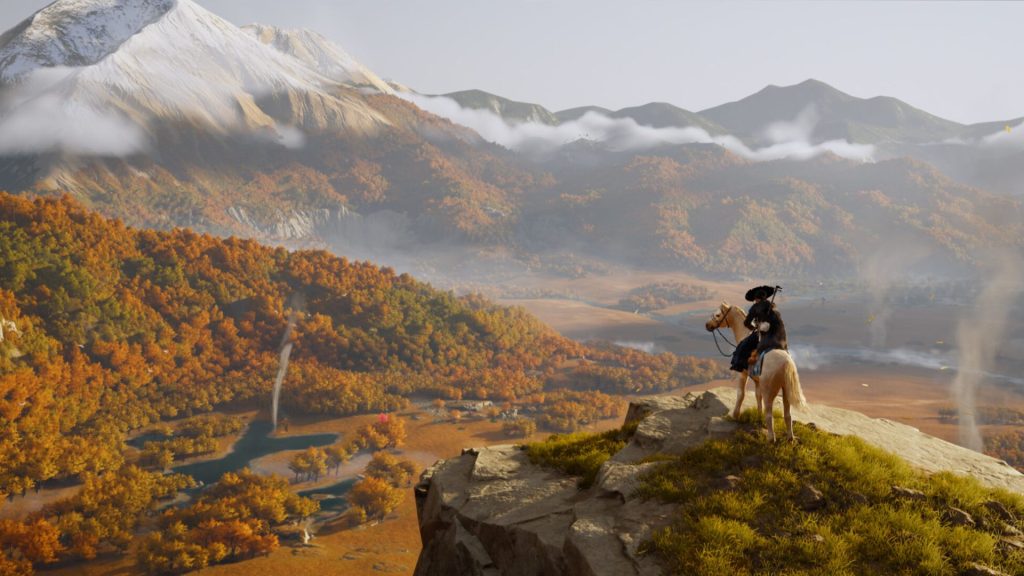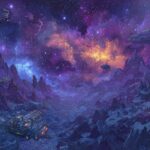There’s a certain allure to an open world in which you just hop onto your horse and let the road lead you to new adventures, or interesting rewards. Ghost of Yotei has finally hit the shelves, and its take on ancient Japan joins a long list of titles that have a lot to see and do in their exploreable maps.
There’s a lot to love about Sucker Punch’s unique fusion of an epic samurai action story and the Wild West. But can it beat the definitive Wild West experience in modern gaming, a classic that many believe to be the king of open worlds? What about the Forbidden West, the stage for another highly successful PlayStation exclusive?
It’s Atsu versus Aurthur and Aloy as we dive into which open world nailed down the things that matter the most in the genre. Let’s get started!
Unique, Eye-Catching Settings
Ancient Japan has had a lot of games visiting various points in its history in recent times. And while Assassin’s Creed Shadows did a great job at recreating the Sengoku period earlier this year, Ghost of Yotei’s take on Ezo is so immersive and visually stunning that it pulls you in right away, and keeps you invested in all of the activities it has to offer. It’s a version of Japan that benefits well from the cinematic flair of numerous samurai action film directors, and Sucker Punch’s raw talent at crafting worlds that have enough to do while keeping players engaged throughout.
Atsu’s adventure saw her travel across fields filled with flowers, witness the peace and tranquility of quaint villages, scale peaks in search of loot and gear, see the devastation of a civil war and the lives it destroyed, and find more than a few iconic spots for duels against incredibly talented opponents. Making the most of what current-gen platforms had to offer, it’s a world that had us stopping on numerous occasions just to take in the sights, and stare slack jawed at the scene in front of us.

That’s not to say that Forbidden West doesn’t do that too. Aloy’s own trek through the frontier beyond the world she once knew is as much of a visual treat, complete with the wreckage of once proud cities and futuristic machines that benefitted well from the PS5’s raw power. The franchise’s unique premise of a world recovering from the hubris of its past citizens has never looked, or felt, better.
But Rockstar’s take on the Wild West in Red Dead Redemption 2 (RDR2) continues to be quite the stunner despite being released for last-gen platforms. Aurthur’s adventure is certainly quite the looker, and his travels across the 1899 American frontier can get quite immersive thanks to visuals that pushed the envelope of what last-gen systems were capable of. And with a potential current-gen update on the cards later this year, this is a game that really sells its setting, and brings it to life in a way that other titles cannot hope to match.
But which one of the three did it best? It’s so hard to pick a favorite among these titles as far as their settings are concerned, and it’s a well-fought tie. But what about the things you get to do in their worlds?
A Lot of Activities and Adventures
Let’s begin with Forbidden West here. Aloy gets many mysteries to solve, machines to fight, people to assist with a variety of requests, and a lot of lore drops that uncover the past and reveal more about the actions of a generation of humanity that’s now long gone. There are hunting grounds, enemy camps, Tallnecks to climb and scan, the newly added underwater exploration systems, and just so many interesting characters for her to meet even as she desperately looks for a way to beat her latest adversaries and thwart their mission to bring ruin to the Earth. Heck, there’s even a mini-game involving a blend of chess and machines!

But things are definitely repetitive once the initial allure wears off. A great setting and a gorgeous map are not enough to save Forbidden West from the fatigue that sets in when a large map features a limited set of activities to take on. Guerilla Games puts up a great fight in this regard but the other two studios we’re discussing simply surge ahead of it thanks to some very well-designed ways to present their offerings.
Ghost of Yotei does have a modicum of repetition in its side content, although the manner in which each activity is framed does stave off boredom to a large degree. For starters, the manner in which you uncover each activity via the new Cards system or through guided, organic exploration that does away with markers and other standard trappings of open world games is a big plus.
Each activity also comes with unique twists, making things unpredictable to a large extent. You might expect an uneventful visit to a nearby mysterious location only to find that you’ll need to take down a trio of vicious ronin who have a sizable bounty on their heads to get there. Or find that you’ll need to put Atsu’s climbing skills to the test in some well-designed sequences that often end with a stunning vista to photograph once you get to the summit. Golden birds pop up almost constantly, distracting you from your objective and leading you to valuable upgrades, stylish weapon kits, or opportunities to play your shamisen or paint a beautiful picture for your home.

The manner in which Yotei presents all it has to offer is so authentic and well-integrated that it allows it to take the win over Forbidden West. But you’ve probably guessed that RDR2 is miles ahead of its rivals, and you’re right. Jumping on your horse and just going in a single direction is bound to give you something to look into, no matter which stage of the game you’re in. What’s more, there’s just so much to do that it feels impossible to see it all in a single playthrough unless you live and breathe in Aurthur’s world for days on end.
It’s hard to forget how a single conversation with a stranger you meet on the road can launch you into a series of activities that could have you wondering what you wanted to do before you got involved with them. As far as finding something to keep you occupied during your travels goes, RDR2 retains its crown, and does so with style!
The Question of Quest Design
Once again, Forbidden West comes in third thanks to a fairly straightforward approach to missions. Aloy meets NPCs, agrees to do a job for them, and once it’s completed, returns to them to claim a reward. While there are twists to these missions, and the potential for more exposition as you take them on, they are largely by the numbers and do not lead her down narrative branches that can have you spending hours tracking down objectives and getting lost in the process. We can’t help but feel that Guerilla Games played it safe on this front, especially considering how the other two titles we’re discussing have been quite adventurous in their approach to quest design.

Yotei takes things up a notch, with several quests resulting in outcomes that allow the characters in question to come back at a later time. It’s hard to forget a bounty hunt resulting in an assault on a nearby stronghold only for the NPC in question to vanish at a very inopportune moment for Atsu. That same NPC later comes back in another guise, only for Atsu to discover that their deception, while morally wrong, stemmed from very noble intentions. It was quite the moment, exposing a humane side to Atsu as well as the NPC. It was also a great opportunity for a few tongue-in-cheek references to another Sucker Punch classic. That’s not bad for a side quest!
But once again, it’s RDR2 that comes out on top. It’s hard to find reasons to not give Rockstar’s epic the win here. It’s not everyday a video game set in the Wild West lets you discover a mad scientist building a robot in the basement of his lab, only for the robot to later kill him and vanish. Or meet a circus owner whose ferocious beasts turn out to be adorable pets in reality. RDR2 has the added advantage of its world simply carrying on irrespective of its players’ involvement, something that both Yotei and Forbidden West cannot match up to.
For instance, if you go hunting for the robot we mentioned earlier, you find it sitting atop a cliff constantly saying “Papa”. A railroad construction project makes gradual progress every time you see it irrespective of whether you’re involved with it in any capacity. NPC scheduling is just insane, with them leading active lives outside of their business with you, and even switching locations in line with the title’s day and night cycle.

In comparison, Atsu and Aloy’s worlds are largely static, their denizens existing only to give you new objectives or reward you for completed ones. While Yotei’s camping system does offset this limitation to a large degree, allowing important NPCs to come to you, and even having them move to new areas that you visit with valid explanations for why they chose to do so, it simply cannot hope to match the scale and scope on offer in RDR2.
An Obvious Winner
RDR2 continues to hold its throne as the most iconic open world game out there despite stellar efforts from both Forbidden West and Ghost of Yotei. It’s an interesting contest, albeit a rather futile one despite there being a lot to like about both Aloy and Atsu’s adventures.
Arthur Morgan’s time with the Van Dyke gang continues to be the undisputed champion as far as having a map that lives and breathes alongside you is concerned. Perhaps the eventual sequels to both Forbidden West and Yotei might put up a better fight when they eventually make their way into our hands.
But until then, Red Dead Redemption 2 remains as the one to beat.
Note: The views expressed in this article are those of the author and do not necessarily represent the views of, and should not be attributed to, GamingBolt as an organization.




This post highlights some fantastic open-world games! Each offers unique experiences and stunning landscapes. It’s always fun to explore different worlds and see where the journey takes you.
Absolutely! Each game does provide a distinct atmosphere and gameplay style. For instance, the way Horizon Forbidden West integrates its environment with combat mechanics really enhances exploration, making it feel dynamic and engaging. It’s fascinating how each title has its own way of inviting players to discover their worlds!
You’re right! Horizon Forbidden West does have a unique blend of vibrant environments and dynamic combat that really sets it apart. The exploration feels rewarding, especially with the diverse ecosystems and creatures you encounter. It’s fascinating how each game’s world can evoke such different feelings while still offering that sense of adventure.